- Here is the untold story of
queens Abbakka I and II, period 1554-1640,
residents of Ullal near Mangalore who took on the Portuguese. Both built
extensive trade relations with the Middle East.
Prof T
Poojary says she is clearly the first woman freedom fighter of India.
This article is part of the Queens
of India series where we share achievements of queens, as warriors and administrators.
It covers background of the Chowta dynasty, where is Tulunadu, Portuguese in
India, Abbakka I, Abbakka II and recognition of Abbaka II.
Abbakka – A Queen of Chowta dynasty
Alupa dynasty, one of the ancient
dynasties of Karnataka ruled over Tulunadu for over a thousand years from
around the 2-mid15th century. After around the tenth century, fourteen
minor dynasties such as Banghas of
Bangadi, Ajilas of Venuru, Bairarasa of Karkala, Savanthas of Mulki,
Dombaheggade of Vittala, Tolaharas of Suraal, Kumble Araarsaru of Kumble,
Chowtas of Puttige, Kellas, Moolas etc emerged and ruled different parts of
Tulunadu. These rulers had internal freedom.
Out of the fourteen dynasties twelve
belonged to Jaina community. Chowtas, who belonged to the Jaina community, had
their administrative centres at Ullal, Puttige and Moodibidre. The Chowtas were
feudatories of the Vijayanagara kingdom. Descendants of the Chowta kings
continue to live in the Chowta Palace in Moodibidri.
To
see pictures of 1000 pillared Jain Mandir at Moodabidri
Jain rulers of Tulunadu followed the matrilineal custom hence Abbakka I inherited the throne from her maternal uncle Thirumalaraya in Ullal.
There was a time when every resident of Tulunadu could elaborately narrate the story of Rani Abbakka. Such was her charisma. The Queen, locally known as Abbakka Mahadevi, was amongst the first of the Indian rulers to give the Portuguese a taste of fear through her valour and patriotism. Her unrequited character has made her a folk legend amongst the Tuluvas.
Where is Tulunadu?
Tulunadu is a
region covering the whole of undivided Dakshina Kannada from Shiroor to
Chandragiri in Kasargod, though its frontier differed from time to time.
Rani Abbakka was
the ruler of a princely state called Ullal
in Tulunadu. It was tucked away between the azure blue of the Arabian Sea and
the verdant greens of the Western Ghats. The history of Tulunadu is instilled
with the indomitable courage of Queen Abbakka whose heroism was at par with
Rani Lakshmi Bai of Jhansi or Rani Chennamma of Kittur. According to historian Dr K.G Vasantha Madhava there were
four Abbakkas in the Chowta lineage.
Yet
little has been documented about her, and history books have largely neglected
her chronicle.
Her furious wars with the Portuguese are not well recorded.
But whatever is available speaks of a luminous personality of awesome valor and
bravery. Archival records, travelogues of Portuguese travelers and historical
analysis confirm that there were three Abbakkas:
mother and two daughters, who fought against the Portuguese Army between 1530
and 1618.
The four Abbakkas in the Chowta lineage are - Abbakka I
(1554-1584) from Ullal, her sister at Puttige by name Loka Devi (1565-1574),
Abbakka II (1594-1640), Abbakka III (1667-1676) and Abbakka IV (1719-1740). In
the Chowta genealogy we find reference of Abbakka in thirteenth century too.
We may therefore, presume that ‘Abbakka’ could be the throne name of these queens. The confusion still persists among historians as to which Abbakka is better known in history. Only a comprehensive study can throw light on the facts of all Abbakkas. However, we cannot deny that all these Abbakkas have richly contributed to the cultural history of Tulunadu through their fair and just administration.
In the present study we are concentrating on Abbakka I
(1554-1584) and Abbakka II (1594-1640) who ruled from a small coastal town of Ullal
near Mangalore. They dared to brawl with Portuguese uncompromisingly for the
cause of their countrymen.
In memory of
this 16th century warrior (1594-1640), Prof. Thukaram Poojary established
a Rani Abbakka Art Gallery and Museum in the Bantwal taluk of Karnataka to give
ode to her accomplishments and seal the memory of this luminous personality in
the world.
Prof
Poojary believes that regional history should provide a strong base in framing
the history of the nation.
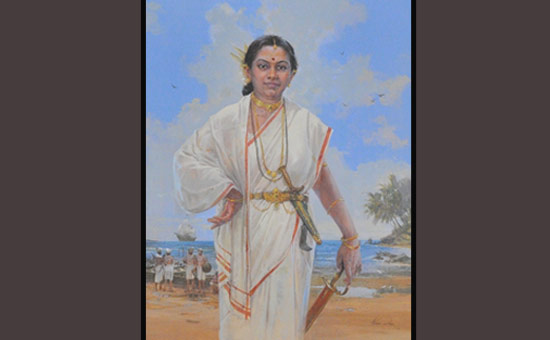 Portrait of Rani Abbakka II at Sanchyagiri in Bantwal. Artist Vasudev Kamat from Mumbai.
Portrait of Rani Abbakka II at Sanchyagiri in Bantwal. Artist Vasudev Kamat from Mumbai.
Portuguese in India
The first of the European troop to set foot on Indian soil
were the Portuguese. The Portuguese king Manuel I sent his navigator Vasco da
Gama, to find a sea route to India via the Cape of Good Hope, the southern tip
of Africa. His landing in India in the year 1498 changed the course of Indian
history.
Portuguese merchants set up a trade empire in the Indian
Ocean by capturing and fortifying all major trading ports including India,
Muscat, Mozambique, Sri Lanka, Indonesia and even Macau in China.
In a short time,
the Portuguese became the masters of trade all over the coast. Later they began
to tax trade in the Indian Ocean, which until then was duty free. With their
strong naval fleet they established supremacy and retained power in the
maritime trade for over a century.
 Refusal to pay Tribute.
Artist is Subhash Kammar.
Refusal to pay Tribute.
Artist is Subhash Kammar.
Abbakka I (1554-1584)
The valour of Abbakka II will be incomplete without a sketch
of the contribution of Abbakka I.
Portuguese captured the Mangalore port in the year 1526. Thereafter,
they made several attempts to capture Ullal. Abbakka I, who was ruling from
Ullal, repulsed every attack with sheer courage and ingenuity. According to
local tradition Abbakka even as a child, was extraordinary and showed signs of
being a visionary. There was no equal to her in military science and warfare,
mainly in archery and sword fighting.
She was married to a neighboring local king of Bangher. The
marriage did not last long, with Abbakka breaking ties by returning the jewels
given by him to her. The husband thus disliked Abbakka and wanted to take revenge.
Later on he joined the Portuguese in a treaty to fight Abbakka.
However, nothing stopped her from protecting her motherland
and people from the vile clutches of the Portuguese. Her first war
against them was in the year 1556 because she refused payment of any kind of
tribute and selling of food stuffs at a rate agreeable to the Portuguese.
Under the leadership
of Dom Alvaro De Silveria 21 fleets of naval ship entered Ullal and attacked
them ruthlessly. As a result, Mangalore fell prey to them. The king of Calicut
Zamorin intervened, mediated, and avoided further disaster. A new agreement was
signed according to which the Queen was to pay tributes.
Within two years
of this battle, in 1558, the Queen had to face the wrath of the Portuguese for
giving shelter to the naval crafts of Malabar. This fight also ended with an
agreement.
For the sake of her
people the Queen of Ullal continued to pay tribute to the Portuguese. The peace
was short-lived as war between the two broke out in 1567 again. The main
contention was that the Queen had stopped paying tribute although the fall of
Vijayanagara in the battle of Talikota in 1565 could have emboldened the
Portuguese. Moreover she had developed trade
contacts through Zamorin, with Persia, Arabia and Red Sea region, by exporting rice, chilly, clothes, cardamom etc. The Portuguese were upset that the Queen had not taken their permission before making these exports.
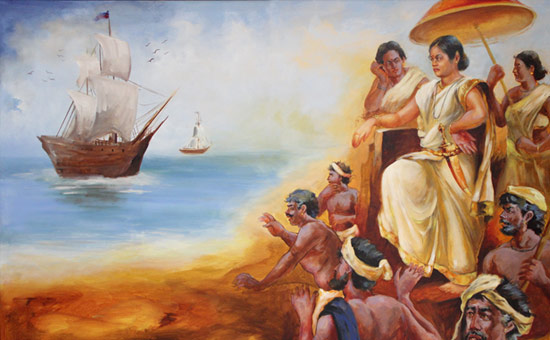 Watching naval fleets from the fort of Ullal is Abbakka II.
Watching naval fleets from the fort of Ullal is Abbakka II.
A letter indicating all this reached the Queen; but she declined to respond. This resulted in a furious battle between the two which caused much loss of men and materials for the duo.
Despite the fact that she did not win the battle, her gallantry fight was praised by the contemporary Portuguese writers like Francisco D’souza, Couto Diogo, and Santos. According to them, she was a brave, heroic, fearless and undaunted queen
of her time who went to war with the Portuguese thrice.
Though she lost
the battle, she sent a strong message to the Portuguese and the world around
that foreign invasions and levying of tributes would no longer be tolerated.
It was the
spirit and actions of Abbakka I that inspired her daughter Abbakka II to defeat
the Portuguese ruthlessly during her time.
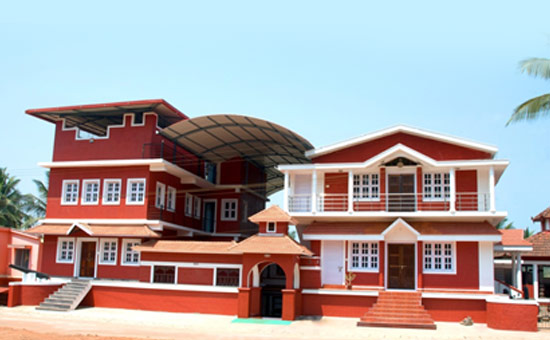 Front View of Rani Abbakka Tulu
Adhyayana Kendra and Tulu Baduku Museum.
Front View of Rani Abbakka Tulu
Adhyayana Kendra and Tulu Baduku Museum.
Abbakka II
(1595-1640)
Rani Abbakka II, the prominent Queen of the Tuluva history, was married to Lakshmappa Bangarasa, a Bangha ruler, who was ruling from Mangalore. Since she had a strained relationship with her husband, the reason being he was supporting Portuguese, the annoyed queen returned her jewelleries given to her in marriage, returns home and assumes her mother’s throne in Ullal.
Like her mother Abbakka II was a very brave and able queen.
The reference about Abbakka II is found in a Portuguese record of 1595. As soon
as she assumed the throne in 1595 she stopped paying tributes to the Portuguese
and built a strong fort at Ullal. Her army was ever vigilant at the fort. All
this annoyed the Portuguese.
During this period she extended her trade relationship with the
Far East including Maldives. Abbakka II also maintained cordial
relations with the King Zamorin of Calicut. All her sea route trading
activities to Middle East countries were thus jointly undertaken. She could export rice, cotton, coconut, sugarcane in her own ships and did not bother about opposition from the Portuguese. They somehow wanted to destroy her fort. According to a Portuguese record they were successful in destroying this fort in 1597.
Unlike her mother Abbakka I who was defeated by the
Portuguese, Abbakka II defeated them in the year 1618.
To achieve her objective she took the help of Keladi
Venkatappa Nayak. Many Portuguese naval chiefs, including Britto Miranda, and two
hundred soldiers died. Around thirty of them fled away from the war fleet. During
the war she effectively used indigenous weapons described as ‘fire arrows’ by the Portuguese.
What
on earth are Fire Arrows?
Fire
Arrows - Torch made of dry coconut leaves popularly known as ‘thoote’ in Tulu language (In Lexicon by Mariyappa Bhatta). ‘Thoote’ was used by Tuluvas in the age
old days as torch during night travel.
Under the queen’s adroit guidance, her soldiers used the thoote as a striking war strategy. Hundreds
of these thoote, blazing with fire, were swung like arrows towards the enemy ships that were anchored near the coast. When the ships caught fire many lost their lives. Rest of the soldiers would jump into the sea to save themselves only to be killed by Abbakka’s soldiers who fought with sword and spears.
Portuguese accepted
defeat
The Portuguese troops succumbed
to the war tactics of the queen. For the first time in history the mighty
Portuguese had to accept defeat against a Queen of a small kingdom. (These thoote’s were wrongly referred as ‘fire arrows’ by Portuguese).
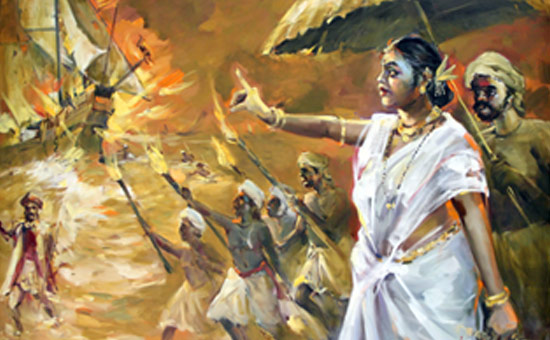 Scene of war-see soldiers holding thoote. Artist is K
Ramachandran from Bengaluru.
Scene of war-see soldiers holding thoote. Artist is K
Ramachandran from Bengaluru.
And so the Queen of a small Coastal town of Ullal defeated
the well-equipped Portuguese flotilla.
The news of the Portuguese loss to a Woman made international
news across Arabia, Persia and Europe. This has been considered as an epoch
making event in contemporary history. Thereafter, the Portuguese never attempted
to attack Ullal or come in the way of her trading activities.
On learning about heroism of this Queen, Persian Traveller
Pietro dellaVelle visited her Court in 1623. His travelogue provides useful
account of her personality and concern for her people.
She was a gentle lady of high dignity, dressed in simple
clothes, yet had an alluring figure. Though her exterior posterity and habit
represented rather a dirty Kitchen wench, or Laundress, than a delicate and
noble Queen; her graceful voice and her prudent and judicious speech bespoke
her nobility says Pietro dala Velle. Another mine of information can be got
from the records of Portuguese historian Antonio Bocaro.
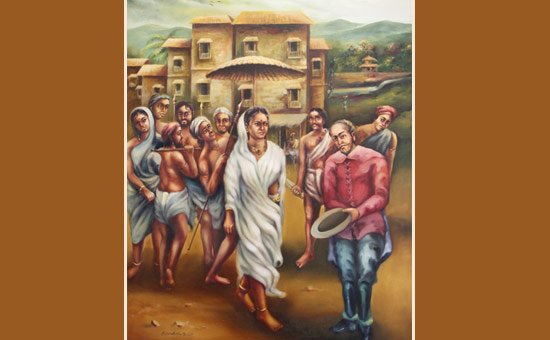 Italian traveler Pietro della velle's visit.
Italian traveler Pietro della velle's visit.
The queen’s story is retold from generation to generation through folk songs and yakshagana, the popular folk theatre. In bootaradhana (which literally means
appeasing the possessed, a local ritual dance) the person in trance narrates
the great deeds of Abbakka Mahadevi. Though
Abbakka has been admired and worshipped in local folk forms, it is only recently
that there have been efforts to honor her memory.
In the history of Tulunadu these two Queens played a pivotal
role. They were undeterred in maintaining self-respect of their country and
countrymen. It was these two Abbakkas who tried to put an end to the political
ambitions of Portuguese who tried to fulfil them in the guise of commercial
activity. Abbakka II was successful in stopping the Portuguese.
Actually Abbakka I and II lit the flame of India’s freedom movement during the 16th century itself. It is time they get due share in the history of freedom movement of the
country. The available inscriptions, travelogues, Portuguese records
should prove the historic role of these forgotten Queens of the Coastal belt.
Recognition for Rani Abbakka
There is great demand from the
public for recognizing Abbakka II, a woman of indomitable spirit. The
government could name Mangalore Airport or Konkan Railway train after her.
Very little has been done to
recognize this naval hero! However, the Indian Navy acknowledged her
achievements by naming a patrol vessel after her in 2012.
There is an Abbakka Circle in
Ullal and Abbakkas statue is installed there. The Abbakka Ustava Samiti was
formulated in 1997 under the aegis of Government of Karnataka. In Bengaluru there
is an Abbakka statue at Yeshawanthpura.
With effect from May 1 2019, a Women’s Police troupe has been named Abbakka Pade. Its aim is to prevent
harassment of women at public places in and around Mangalore.
The Rani Abbakka Tulu Adhyayana Kendra (founded in 1995) has recognized this valiant Queen of Coastal Karnataka by naming the institution after her. They also have a Rani Abbakka Art Gallery that exhibits various stages of the Queen’s life on canvas, painted through the brush strokes of renowned artists from all over India.
Prof. Thukaram
Poojary, the founder of Rani Abbakka Tulu Museum, has taken upon himself the
task of documenting the narrative of Queen Abbakka so that her name lives on,
undeterred by the sands of time.
Another challenging
but achievable idea is to compile the paintings into a booklet so that the
world gets to know about her. This is one more effort to ensure the name of
this profound Queen is not lost amidst the other magnified freedom fighters.
Author is Secretary, Rani Abbakka Tulu Adhyayna Kendra, Bantwal.
Pictures are courtesy Prof Thukaram Poojary, Founder and President, Rani
Abbakka Tulu Adhyayana Kendra (1995).
Also read about
1 Rani Laxmibai of Jhansi
2 Warrior Queen Durgawati
3 Kittur Rani Chennamma
4 Ahom Queen – Sati Joymati